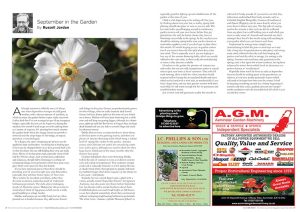
Although summer is officially over, it’s always nice when September manages to yield good weather, with a decent amount of sunshine, in which to enjoy the garden before it gets really autumnal. I often find that I’ve not managed to get all my evergreen hedges, especially the yew, cut in August so, during dry weather, this month I tend to get on with tackling them as a matter of urgency. It’s amazing how much smarter the garden looks when the shaggy extension growth is removed and the crisp shape of the hedge, or topiary specimen, is revealed again.
To a degree, the same ‘sharpening up’ process can be applied to beds and borders. Anything that is looking past its best can be chopped down or, at least, pruned back a bit so that the plants that are still holding their own can really shine. Plenty of the late perennials, especially those which had the ‘Chelsea chop’, such as heleniums, rudbeckias and echinacea, should still be blooming so cutting out competing foliage, from perennials which have gone over, gives them some space for their last hurrah.
If you have perennial grasses then these should be providing a lot of structure right now and, Miscanthus especially, they will have flower spikes of their own. These tend to be tasselled, or feathery, rather than the more exuberant, colourful, petals of traditional herbaceous perennials. The dark, almost mahogany, tassels of Miscanthus sinensis ‘Malepartus’ always come to mind when I think of big grasses which can be a really good backdrop in a large border.
Dahlias and cannas are not fully hardy but are often planted out in borders because they add exotic flowers and foliage to the party. Cannas are predominantly grown for their foliage, often in really dramatic dark leaved forms, but have flower spikes at this time of year which are a bonus. Dahlias will have been flowering for a while now and will keep on getting bigger, although at a slower pace, right up until the first frosts as long as they are kept dead headed and you are able to control slugs and snails by whatever means.
Dahlia flowers have a certain freshness about them, at this late point in the growing season, and there are plenty of autumn flowering bulbs which bring a similar level of spring-like vitality to the garden. Autumn crocus and Colchicums are useful for naturalising under trees and in grass, although you need to allow for their large leaves which persist for many months after the flowers have gone.
Cyclamen hederifolium often starts flowering, fitfully, before the end of summer as soon as it detects moister soils and a drop in temperature. This cyclamen spreads easily and is especially welcome as it has dainty blooms, in shades from white, through pink to purple, followed by marbled foliage which looks vaguely ivy-like (hence its Latin name : hederifolium).
Similarly, but on a march larger scale, a plant with a variety actually named ‘September Charm’, the Japanese Anemone, may also come into flower before September but has blooms with a certain freshness about them. Established plants can reach head height, in full flower, so are best planted somewhere where they can luxuriate without swamping neighbouring herbaceous perennials. The white form, Anemone x hybrida ‘Honorine Jobert’, is especially good for lighting up semi-shaded areas of the garden at this time of year.
I find it a bit depressing to be writing off this year, by thinking about next year, but, in reality, spring bulb planting should take place as soon as you are able. The less time bulbs spend hanging around in warehouses, garden centres and your own home, before they get planted into the soil, the better chance they have of blooming successfully in the spring. At the very least you should be ordering spring bulbs now, via the internet or mail-order suppliers, even if you don’t get to plant them this month. It’s worth keeping an eye on garden centres too if you want to have the first pick when they come into stock. This is especially true if you are hoping to buy any of the autumn flowering bulbs, which are usually offered at the same time, as these really do need planting as soon as they become available.
Elsewhere in the garden the promise of autumn rain and cooler, but not yet cold, temperatures makes it a good time to give your lawns a bit of attention. They will still need mowing, albeit a little less often, but they should respond well to having the accumulated thatch and moss raked out by hand with a wire rake, or mechanically if you have a large lawn, and any bare patches resown with lawn seed while it’s still warm enough for this to germinate and establish before winter.
Just as lawn seed will germinate readily this month so will seed of hardy annuals. If you can be sure that they will remain undisturbed then hardy annuals, such as Calendula (English Marigolds), Centaurea (Cornflowers) and Papaver (Poppies), can be sown directly where you want them to flower next year. The flip side of sowing seed in the autumn is that seed can also be collected from any plant that is still holding onto it and which you want to make more of. Annuals and biennials are chief amongst these but it’s also worth trying with anything in your garden which you can harvest seed from.
Experiment by sowing some straight away (remembering to label the pots or seed trays as it may take a long time for germination to take place) and saving some seed, collected when dry and then keeping the packets cool and dry while in storage, for sowing in the spring. Autumn sown seed may only germinate in the spring, once it has spent the winter outdoors, having been subjected to winter frosts which break its dormancy in a process known as ‘vernalisation’.
Hopefully there won’t be frosts as early as September but you should be making space in the greenhouse, or indoors, if you have tender perennials in pots which will need to be kept frost-free over the winter. I shall be keeping everything crossed for a balmy beginning of autumn and then a nice, gradual, descent into ‘proper’ cooler conditions with the inevitable leaf-fall which is just around the corner.




